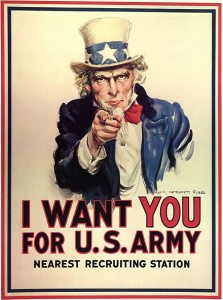What is the history of Uncle Sam?
 March 13, 1852 — Frank Bellew’s cartoon, “Uncle Sam,” made its debut today in the NY Lantern Weekly.
March 13, 1852 — Frank Bellew’s cartoon, “Uncle Sam,” made its debut today in the NY Lantern Weekly.
The character’s name is attributed to Samuel Wilson, a meat packer who supplied food to the troops during the War of 1812. Legend has it that he conspicuously marked “U.S.” on the packages and before long the soldiers took to calling him “Uncle Sam.”
However, the first use in literature of the concept of the patriot Uncle Sam was in the 1816 book, “The Adventures of Uncle Sam in Search After His Lost Honor,” by Frederick Augustus Fidfaddy, Esq.
And, Uncle Sam is mentioned as early as 1775, in the original “Yankee Doodle” lyrics of the American Revolutionary War.
Did you know: New Yorker cartoonist Thomas Nast, who created political party mascots and Santa Claus, is often credited with creating the Uncle Sam archetype. While he may have popularized it, Nast was just 12 years old when that cartoon originally appeared. And, historians argue that the image did not take hold in popular consciousness until the iconic “Uncle Sam Wants You” recruitment poster made by James Montgomery Flagg during WW I.
Sources
Words of Wisdom
Old Uncle Sam come there to change, some pancakes and some onions, for 'lasses cakes, to carry home, to give his wife and young ones.





